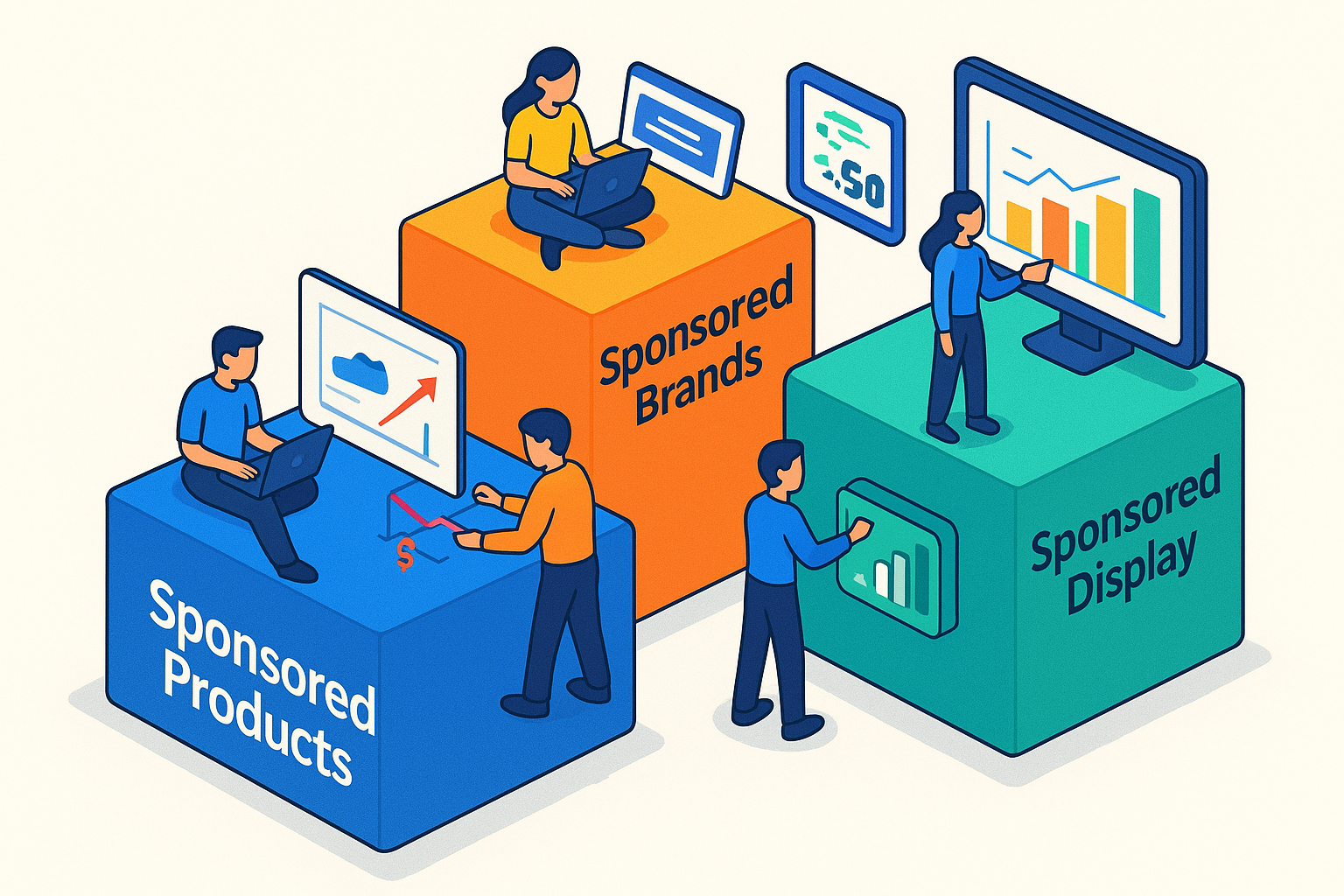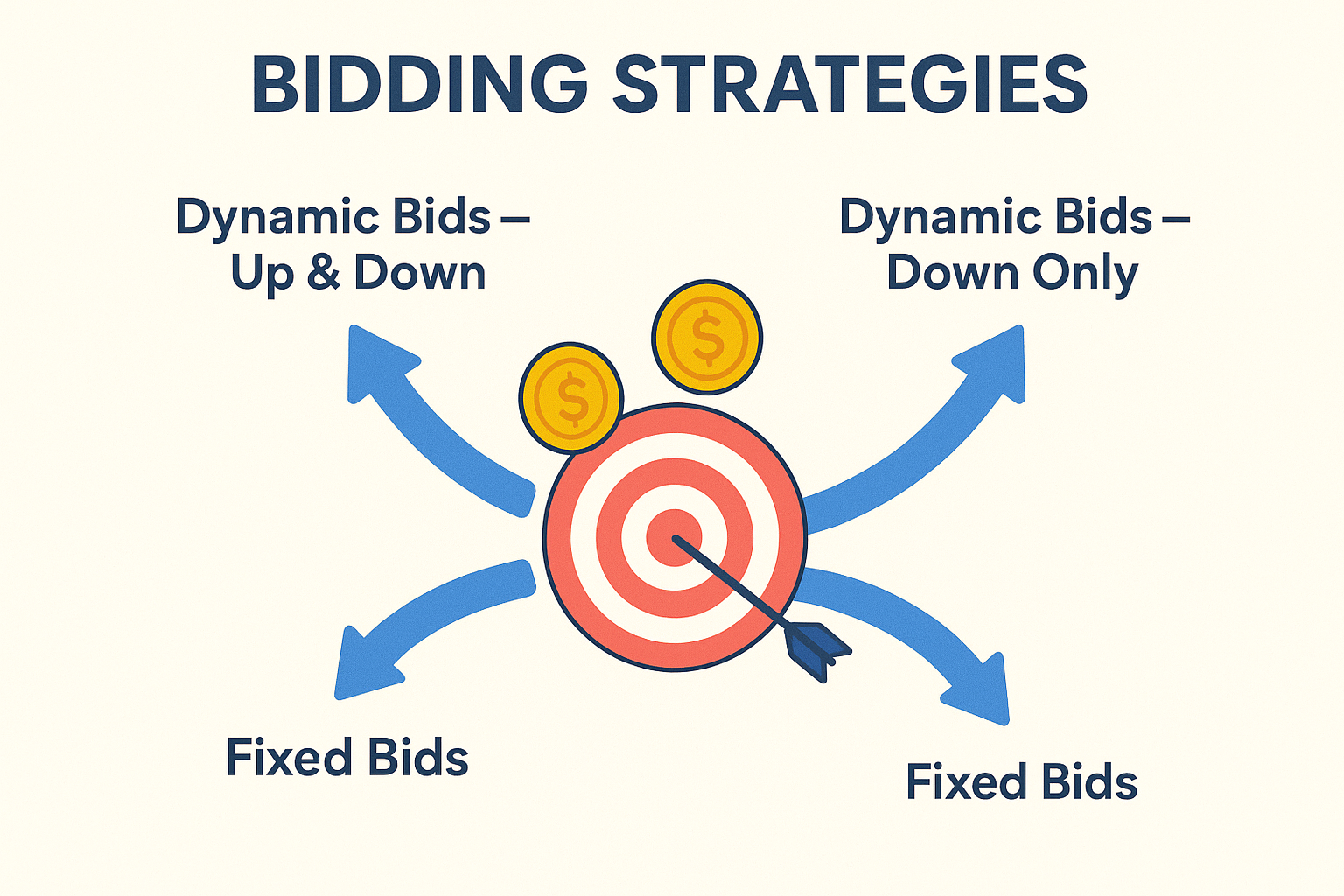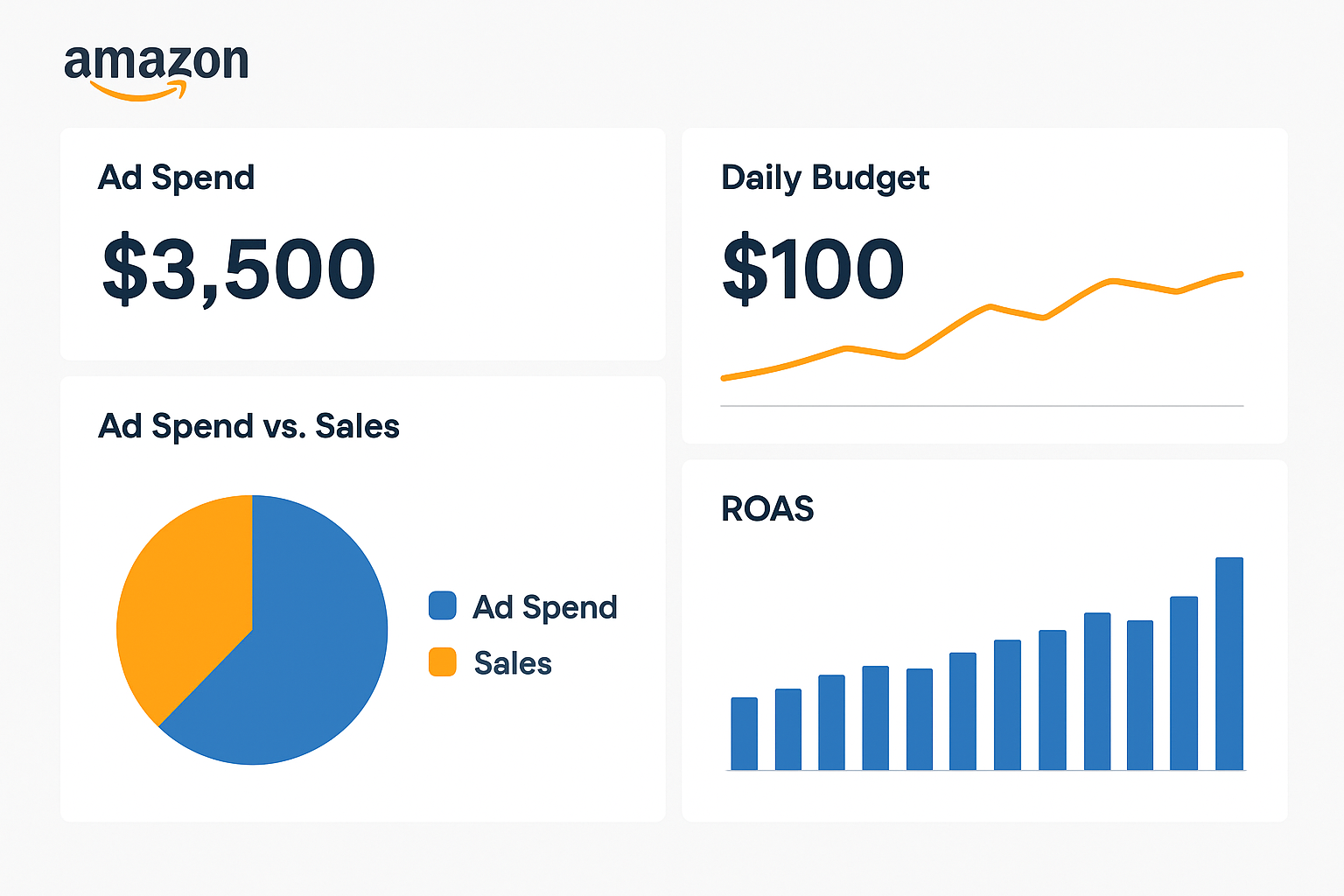Amazon PPC for Beginners: Campaign Types, Bidding, Budgeting
Amazon PPC Powers Sales
Key Takeaways
| Topic | What You’ll Learn |
|---|---|
| Campaign Types | Sponsored Products, Sponsored Brands, Sponsored Display – which to use and why |
| Bidding | Manual bidding, automatic bidding, dynamic bidding, and bid optimization for beginners |
| Budgeting | Daily budgets, low-budget strategies, scaling, and cost management |
| Optimization | Common mistakes, how to refine campaigns, and long-term growth tips |
1. Introduction to Amazon PPC for Beginners
Amazon is the world’s biggest e-commerce marketplace. If you’re selling on Amazon Seller Central, you’ve probably heard of Amazon PPC (Pay-Per-Click). It’s how sellers like you can get products in front of shoppers when they search on Amazon.com.
When you pay for clicks, your product shows up right alongside brands like Nike, Apple, or even Samsung. The best part? You only pay if someone actually clicks.
But here’s the thing: as a beginner, it can feel like a jungle. That’s why we’re breaking down campaign types, bidding, and budgeting—so you can get sales without wasting money.

Amazon PPC for beginners’ guide
Think of PPC as a race for attention. Amazon lets you buy better spots in search results. When shoppers search “wireless headphones,” your ad can appear before listings from Sony or Bose.
Amazon PPC advertising basics
-
-
You pay when someone clicks your ad.
-
Ads can appear on search pages, product detail pages, and even off-Amazon.
-
-
It helps boost visibility, improve ranking, and drive sales.
Amazon PPC beginner’s strategy
Start small. Choose a few products, set a clear budget, and watch performance. Don’t try to outspend big brands. Instead, use smart tactics like long-tail keywords.
Table: Beginner-Friendly PPC Terms
| Term | Meaning |
|---|---|
| CPC | Cost per click: what you pay for one click |
| ACoS | Advertising cost of sales, ad spend ÷ revenue |
| CTR | Click-through rate, % of people clicking |
| Impressions | How many times does your ad show |
Bullets: Why PPC Matters for Beginners
-
Levels the playing field with big sellers
-
Builds traffic even for new brands
-
Gives data for future keyword planning
2. Setting Up Your First Campaign

Once you know the basics, it’s time to dive into Amazon Seller Central and create your first campaign. Don’t worry—it’s not rocket science.
Step-by-step Amazon PPC tutorial
-
Log in to Seller Central.
-
Go to Campaign Manager under Advertising.
-
Click “Create Campaign.”
-
Choose your campaign type.
-
Add products, set bids, and assign a budget.
How to set up Amazon PPC campaigns
-
Pick products with strong reviews and images.
-
Use relevant keywords from tools like Helium 10 or Jungle Scout.
-
Set default bids based on Amazon’s suggestions.
Amazon PPC campaign structure for beginners
Campaigns → Ad Groups → Ads. Think of it like a family tree. Each campaign has ad groups, and each ad group has ads.
Table: Campaign Setup Checklist
| Step | Action |
|---|---|
| Product | Select the top-selling item |
| Keywords | Add relevant search terms |
| Bids | Choose manual or automatic |
| Budget | Set daily spend |
| Launch | Review and start the campaign |
Bullets: Rookie Mistakes in Setup
-
Adding too many products to one ad group
-
Ignoring keyword match types
-
Forgetting to track conversions
3. Amazon PPC Campaign Types
Not all campaigns are the same. Amazon gives you three main types.
Amazon PPC campaign types explained
-
Sponsored Products = show on search results & detail pages.
-
Sponsored Brands = show logo + products at the top of the search.
-
Sponsored Display = show on competitor listings or off-Amazon.
Sponsored Products campaign setup for beginners
This is the bread and butter of Amazon PPC. Great for individual products.
Sponsored Brands campaigns explained for PPC beginners
Perfect if you’re a registered brand. Lets you showcase multiple items and your logo.
Sponsored Display campaigns for new Amazon sellers
These ads help you retarget shoppers or defend against competitors.
Best Amazon PPC campaign types for beginners
Most beginners should start with Sponsored Products. It’s cost-effective and data-rich.
Choosing the right Amazon PPC campaign type
-
If you want traffic → Sponsored Products.
-
If you want brand awareness → Sponsored Brands.
-
If you want retargeting → Sponsored Display.
Table: Campaign Types at a Glance
| Type | Best For |
|---|---|
| Sponsored Products | Sales + visibility |
| Sponsored Brands | Brand recognition |
| Sponsored Display | Retargeting shoppers |
Bullets: Campaign Type Tips
-
Don’t launch all three at once
-
Test one type, then expand
-
Use A/B testing for creatives
4. Amazon PPC Bidding Strategies
Bidding decides if your ad shows up or not. Bid too low? Your ad won’t show. Bid too high? You’ll burn cash.

Amazon PPC bidding strategies for beginners
-
Automatic bidding: Amazon adjusts your bids.
-
Manual bidding: You set exact bids.
-
Dynamic bidding: Amazon raises/lowers bids in real time.
Amazon PPC manual vs automatic bidding
Automatic is easy for beginners, and manual gives more control.
Amazon PPC dynamic bidding explained
Amazon can lower bids if the conversion chance is low or raise them if high.
Amazon PPC manual bidding vs auto bidding
Manual is hands-on, auto is hands-off. Use both at different stages.
Amazon PPC bidding tips for beginners
-
Start with Amazon’s suggested bid.
-
Don’t chase top spot if it kills profits.
-
Adjust weekly.
How to optimize Amazon PPC bids
Check Search Term Reports. Cut wasteful keywords, boost winners.
Amazon PPC bid strategy for low-budget sellers
Go for long-tail, low-competition keywords. Example: Instead of “headphones,” bid on “kids wireless headphones with mic.”
Table: Bidding Approaches
| Method | Control | Best Use |
|---|---|---|
| Auto | Low | Beginners |
| Manual | High | Experienced sellers |
| Dynamic | Medium | Mixed campaigns |
Bullets: Bid Management Tips
-
Watch ACoS weekly
-
Don’t let bids run wild
-
Use negative keywords
5. Amazon PPC Budgeting & Cost Management
You don’t need deep pockets like Procter & Gamble to win. Budget smart, not big.
Amazon PPC budgeting tips
Allocate funds based on product margins.
Amazon PPC daily budget guide
Set a realistic daily cap. Example: $20/day for one product.
Amazon PPC budget allocation for beginners
Spread across 1–2 products. Don’t spread too thin.
How to set a daily budget in Amazon PPC
Inside campaign manager → daily budget. Simple as that.
Amazon PPC low-budget strategies
Target niche keywords, avoid broad ones.
Managing Amazon PPC spend for beginners
Check reports daily. Pause poor performers.
Scaling Amazon PPC with proper budgeting
As sales grow, increase the budget slowly.
Table: Budget Planning Example
| Product | Margin | Suggested Daily Budget |
|---|---|---|
| Headphones | 40% | $25 |
| Phone Case | 25% | $10 |
| Coffee Mug | 50% | $15 |
Bullets: Budget Wisdom
-
Never overspend early
-
Focus on ROI, not clicks
-
Scale only after profits
6. Optimization & Common Pitfalls
Even pros slip up. Knowing pitfalls saves money.
Amazon PPC optimization for beginners
Use reports to tweak keywords and bids weekly.
Common Amazon PPC mistakes to avoid
-
Not adding negative keywords
-
Setting and forgetting campaigns
-
Copying competitor bids blindly
How to start Amazon PPC with a small budget
Start with $10/day. Use long-tail keywords and Sponsored Products.
Table: Optimization Checklist
| Task | Frequency |
|---|---|
| Review ACoS | Weekly |
| Add negatives | Bi-weekly |
| Adjust bids | Weekly |
| Test new ads | Monthly |
Bullets: Optimization Keys
-
Track every dollar spent
-
Adjust campaigns like a gardener trims plants
-
Patience pays off
Conclusion
Amazon PPC is like fuel for your product engine. With the right campaign type, bidding approach, and budget plan, even small sellers can compete with giants like Unilever or Coca-Cola. The secret isn’t spending big—it’s spending smart.
Call to Action
Ready to dive in? Log into Amazon Seller Central, set up your first Sponsored Products campaign, and watch what happens. Start small, stay sharp, and let your ads work like a magnet pulling in shoppers.
👉 The earlier you start, the faster you’ll learn. Don’t just sell—advertise with purpose and watch your brand shine on Amazon.
Frequently Asked Questions about Amazon PPC
1. What is Amazon PPC?
Amazon PPC (Pay-Per-Click) is Amazon’s advertising platform where sellers pay only when shoppers click their ads. It includes Sponsored Products, Sponsored Brands, and Sponsored Display campaigns. PPC helps sellers rank higher in search, drive traffic, and increase sales on the Amazon Marketplace.
2. Which Amazon PPC campaign type is best for beginners?
Most beginners should start with Sponsored Products campaigns. These ads are easy to set up, cost-effective, and focus on promoting individual items. As you gain confidence, you can expand to Sponsored Brands for brand awareness and Sponsored Display for retargeting.
3. How do I set a daily budget in Amazon PPC?
Inside Amazon Seller Central, go to Campaign Manager. When creating or editing a campaign, you’ll find a Daily Budget field. Beginners often start with $10–$20 per day per product, then adjust based on performance.
4. What’s the difference between manual and automatic bidding?
-
Manual bidding: You set exact bid amounts for keywords. This gives more control but requires monitoring.
-
Automatic bidding: Amazon’s algorithm adjusts bids in real-time based on competition and shopper behavior. Great for beginners who want a hands-off approach.
5. What are common Amazon PPC mistakes to avoid?
-
Not adding negative keywords (leads to wasted ad spend).
-
Ignoring Search Term Reports.
-
Setting and forgetting campaigns without monitoring.
-
Overspending on broad keywords with high competition.
-
Copying competitor bids without analyzing profitability.
6. What is a good ACoS in Amazon PPC?
ACoS (Advertising Cost of Sales) is calculated by dividing ad spend by ad revenue. A “good” ACoS depends on your product margin. For example, if your profit margin is 30%, an ACoS of 20–25% is solid. For launch campaigns, sellers sometimes accept higher ACoS to gain ranking on Amazon search results.
7. How does ROAS differ from ACoS?
ROAS (Return on Ad Spend) measures how much revenue you make for every $1 spent on ads. For example, if you spend $100 and earn $400, your ROAS is 4.0. ACoS is the inverse—ad spend ÷ revenue. Both metrics are vital in Amazon Advertising Console. High ROAS = lower ACoS.
8. What are keyword match types in Amazon PPC?
Amazon Sponsored Products uses three keyword match types:
-
Broad Match → triggers ads for variations of a keyword (e.g., “coffee mug” → “ceramic coffee cup”).
-
Phrase Match → triggers ads when the search includes the exact phrase (e.g., “coffee mug with lid”).
-
Exact Match → triggers ads only when the search is exactly the keyword.
Smart sellers mix all three for better coverage.
9. How do negative keywords improve Amazon PPC?
Negative keywords prevent your ads from showing on irrelevant searches. For example, if you sell premium leather wallets, you might add “cheap wallet” as a negative keyword. This saves budget and improves CTR (Click-Through Rate) and conversion rate.
10. How often should I optimize my Amazon PPC campaigns?
-
Daily: Monitor spend and ACoS on top campaigns.
-
Weekly: Adjust bids, add negative keywords, review search terms.
-
Monthly: Scale winning campaigns, cut underperformers, and refine keyword strategy.
Regular optimization in Amazon Seller Central ensures you don’t waste money and keeps ads competitive against sellers like Nike or Adidas.